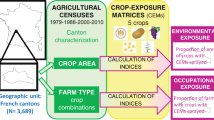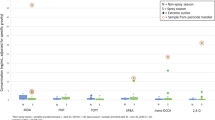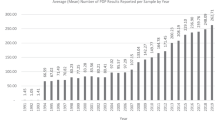Abstract
Exposure to certain pesticides has been linked with both acute and chronic adverse health outcomes such as neurotoxicity and risk for certain cancers. Univariate analyses of pesticide exposures may not capture the complexity of these exposures since use of various pesticides often occurs simultaneously, and because specific uses have changed over time. Using data from the Agricultural Health Study, a cohort study of 89,658 licensed pesticide applicators and their spouses in Iowa and North Carolina, we employed factor analysis to order to characterize underlying patterns of self-reported exposures to 50 different pesticides. Factor analysis is a statistical method used to explain the relationships between several correlated variables by reducing them to a smaller number of conceptually meaningful, composite variables, known as factors. Three factors emerged for farmer applicators (N=45,074): (1) Iowa agriculture and herbicide use, (2) North Carolina agriculture and use of insecticides, fumigants and fungicides, and (3) older age and use of chlorinated pesticides. The patterns observed for spouses of farmers (N=17,488) were similar to those observed for the farmers themselves, whereas five factors emerged for commercial pesticide applicators (N=4,384): (1) herbicide use, (2) older age and use of chlorinated pesticides, (3) use of fungicides and residential pest treatments, (4) use of animal insecticides, and (5) use of fumigants. Pesticide exposures did not correlate with lifestyle characteristics such as race, smoking status or education. This heterogeneity in exposure patterns may be used to guide etiologic studies of health effects of farmers and other groups exposed to pesticides.
This is a preview of subscription content, access via your institution
Access options
Subscribe to this journal
Receive 6 print issues and online access
$259.00 per year
only $43.17 per issue
Buy this article
- Purchase on Springer Link
- Instant access to full article PDF
Prices may be subject to local taxes which are calculated during checkout
Similar content being viewed by others
References
Alavanja M.C.R., Sandler D.P., McMaster S.B., Zahm S.H., McDonnell C.J., Lynch C.F., Pennybacker M., Rothman N., Dosemeci M., Bond A.E., and Blair A. The Agricultural Health Study. Environ Health Perspect 1996: 104: 362–369.
Alavanja M.C.R., Samanic C., Dosemeci M., Lubin J., Tarone R., Lynch C.F., Knott C., Thomas K., Hoppin J.A., Barker J., Coble J., Sandler D.P., and Blair A. Use of agricultural pesticides and prostate cancer risk in the Agricultural Health Study cohort. Am J Epidemiol 2003: 157: 800–814.
California Environmental Protection Agency. Department of Pesticide Regulation and United States Environmental Protection Agency. Pesticide Product Information Query Site, 2002, ( http://www.cdpr.ca.gov/docs/epa/epamenu.htm).
Coble J., Hoppin J.A., Engel L., Elci O.C., Dosemeci D., Lynch C.F., and Alavanja M.C.R. Prevalence of exposure to solvents, metals, grain dust and other hazards among farmers in the Agricultural Health Study. J Exp Anal Environ Epidemiol 2002: 12: 418–426.
Floyd F.J., and Widaman K.F. Factor analysis in the development and refinement of clinical assessment instruments. Psych Assess 1995: 7: 286–299.
Gorsuch R.L. Factor Analysis. Lawrence Erlbaum Associates, Pubs, Hillsdale, NJ, 1983.
Gupta R.K., Kumar A., and Singh P. Factor analysis of acute respiratory infections among under fives in Delhi slums. Indian Pediatrics 1999: 36: 1146–1149.
Hatcher L. A Step-by-Step Approach to Using the SAS System for Factor Analysis and Structural Equation Modeling. SAS Institute Inc., Cary, NC, 1994.
Hines C.J., Deddens J.A., Tucker S.P., and Hornung R.W. Distributions and determinants of pre-emergent herbicide exposures among custom applicators. Ann Occup Hyg 2001: 45: 227–239.
Kleinbaum D.G., and Kupper L.L. Applied Regression Analysis and Other Multivariate Methods. MA, Duxbury Press, North Scituate, 1978.
Lubin J.H., Burns P.E., and Blot W.J., et al. Dietary factors and breast cancer risk. Int J Cancer 1981: 28: 685–689.
Marusic A. Factor analysis of risk for coronary heart disease: an independent replication. Int J Cardiol 2000: 75: 233–238.
SAS Institute. SAS, version 8.2. SAS Institute, Cary, NC, 2001.
Terry P., Suzuki R., Hu F.B., and Wolk A. A prospective study of major dietary patterns and the risk of breast cancer. Cancer Epidemiol Biomarkers Prev 2001: 10: 1281–1285.
Zahm S.H., Ward M., and Blair A. Pesticides and cancer. Occup Med: State of the Art Rev 1997: 12: 269–289.
Author information
Authors and Affiliations
Corresponding author
Rights and permissions
About this article
Cite this article
Samanic, C., Hoppin, J., Lubin, J. et al. Factor analysis of pesticide use patterns among pesticide applicators in the Agricultural Health Study. J Expo Sci Environ Epidemiol 15, 225–233 (2005). https://doi.org/10.1038/sj.jea.7500396
Received:
Accepted:
Published:
Issue Date:
DOI: https://doi.org/10.1038/sj.jea.7500396
Keywords
This article is cited by
-
Construct validity for the self-reported competency and sub-construct associated characteristics of Romanian physicians in autism spectrum disorder
BMC Medical Education (2021)
-
A principal factor analysis to characterize agricultural exposures among Nebraska veterans
Journal of Exposure Science & Environmental Epidemiology (2017)



